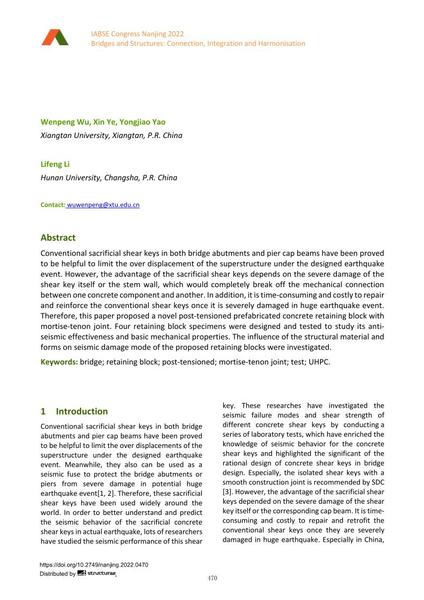Experimental Study of the Post-Tensioned Prefabricated Retaining Blocks with Mortise-Tenon Joint

|
|
|||||||||||
Bibliografische Angaben
| Autor(en): |
Wenpeng Wu
(Xiangtan University, Xiangtan, P.R. China)
Xin Ye (Xiangtan University, Xiangtan, P.R. China) Yongjiao Yao (Xiangtan University, Xiangtan, P.R. China) Lifeng Li (Hunan University, Changsha, P.R. China) |
||||
|---|---|---|---|---|---|
| Medium: | Tagungsbeitrag | ||||
| Sprache(n): | Englisch | ||||
| Tagung: | IABSE Congress: Bridges and Structures: Connection, Integration and Harmonisation, Nanjing, People's Republic of China, 21-23 September 2022 | ||||
| Veröffentlicht in: | IABSE Congress Nanjing 2022 | ||||
|
|||||
| Seite(n): | 470-476 | ||||
| Anzahl der Seiten (im PDF): | 7 | ||||
| DOI: | 10.2749/nanjing.2022.0470 | ||||
| Abstrakt: |
Conventional sacrificial shear keys in both bridge abutments and pier cap beams have been proved to be helpful to limit the over displacement of the superstructure under the designed earthquake event. However, the advantage of the sacrificial shear keys depends on the severe damage of the shear key itself or the stem wall, which would completely break off the mechanical connection between one concrete component and another. In addition, it is time-consuming and costly to repair and reinforce the conventional shear keys once it is severely damaged in huge earthquake event. Therefore, this paper proposed a novel post-tensioned prefabricated concrete retaining block with mortise-tenon joint. Four retaining block specimens were designed and tested to study its anti- seismic effectiveness and basic mechanical properties. The influence of the structural material and forms on seismic damage mode of the proposed retaining blocks were investigated. |
||||
| Stichwörter: |
Brücke Versuch Test UHPC
|
||||
| Copyright: | © 2022 International Association for Bridge and Structural Engineering (IABSE) | ||||
| Lizenz: | Die Urheberrechte (Copyright) für dieses Werk sind rechtlich geschützt. Es darf nicht ohne die Zustimmung des Autors/der Autorin oder Rechteinhabers/-in weiter benutzt werden. |
||||
